- Published by:
- Life Magazine
- Interview by:
- Thomas Thompson
- Timeline More from year 1967
- Location:
- EMI Studios, Studio Two, Abbey Road
- Album This interview has been made to promote the Sgt. Pepper's Lonely Hearts Club Band (UK Mono) LP.
Timeline
More from year 1967
Songs mentioned in this interview
Officially appears on Sgt. Pepper's Lonely Hearts Club Band (UK Mono)
Officially appears on Sgt. Pepper's Lonely Hearts Club Band (UK Mono)
Officially appears on Strawberry Fields Forever / Penny Lane
Other interviews of The Beatles
October 2000 • From MOJO
October 1999 • From MOJO
“The Beatles Anthology 1” press conference
Nov 20, 1995
Calm down! It's The Beatles. Their only interview!
December 1995 • From Q Magazine
Andy Gray talks to the Beatles, 1968
Jul 13, 1968 • From New Musical Express
Interview for The Kenny Everett Show
Jun 09, 1968 • From BBC Radio 1
Interview for The Village Voice
May 16, 1968 • From The Village Voice
May 14, 1968 • From WNDT
NYC Press Conference Announcing Apple
May 14, 1968
Interview for The Tonight Show
May 14, 1968 • From NBC
Interviews from the same media
The case of the missing Beatles - Paul is still with us
Nov 07, 1969 • From Life Magazine
Apr 16, 1971 • From Life Magazine
Spread the love! If you like what you are seeing, share it on social networks and let others know about The Paul McCartney Project.
Interview
This interview remains the property of the respective copyright owner, and no implication of ownership by us is intended or should be inferred. Any copyright owner who wants something removed should contact us and we will do so immediately.
On February 28, 1967, The Beatles rehearsed “Lucy In The Sky With Diamonds” at EMI Studios, Abbey Road. They were visited by a reporter from Life magazine named Thomas Thompson and photographer Henry Grossman. This visit led to an article about the session being published in the June 16, 1967, edition of Life Magazine. In the article, Paul McCartney admitted to taking LSD. The UK press quickly picked up on this revelation, and three days later, Paul gave a statement to Independent Television News (ITN).
The article contains various photos from the rehearsal session, a photo of John Lennon and a photo of George Harrison taken by Henry Grossman on February 25, 1967, and a photo of The Beatles taken in Hyde Park on May 18, 1967, by Marvin Lichtner.
Paul rang me one Saturday afternoon to tell me that he had admitted to the press that he had taken LSD… I was very worried. I don’t think I slept that night and I thought about it all the following day.
Brian Epstein – From “The Beatles: Off the Record” by Keith Badman, 2008
The Beatles’ involvement with drugs has been massively exaggerated over the years, but they certainly experimented more than most people. It was Paul who first admitted the truth to the Press in a very unscheduled interview which I tried hard to interrupt.
I had been asked round to see Paul at Cavendish Avenue, but when I arrived the security gates were firmly shut and I couldn’t raise an answer on the security intercom. But I knew Paul was in because I could hear his voice. I was forced to resort to climbing over the wall. Not very dignified for a smart-suited executive, I know. But, hey, this is the crazy music business. I scrambled down inside the large and elegant gardens and, to my horror, I heard Paul cheerfully confessing to using marijuana because he found it so relaxing. My heart sank into my shiny shoes when I realised the guy he was talking to was a reporter. With as much confidence and authority as I could muster, which was pretty well zero, I tried to interrupt this impromptu press conference which I was convinced was instantly going to burst the bubble of popularity the Beatles had inflated.
‘Er, Paul,’ I bumbled, ‘could I have a word?’
‘It’s OK, Al. It’s cool,’ said Paul without removing the easy grin from his face.
‘But, I’m not sure that Brian would …’
‘It’s OK, Al. Relax. It’s time the truth came out.’
I was horrified, because at this time there had been accusations and colourful stories and all the rest of it but none of the Beatles had stood up and admitted that they used illegal drugs. Paul clearly thought the time for this hypocrisy was over and the reporter’s notebook was by now twitching nervously in case this scoop was going to be snatched away from him. Paul introduced me to the reporter and told me to relax and carried on telling the world how much the Beatles enjoyed smoking cannabis. It did create a storm but the Beatles weathered it easily and I came to realise the extent of Paul’s talent for public relations. He hadn’t talked to Brian or the other three before going public. And for all the notice he took of my nervous warnings, I might as well have stayed on the other side of the wall.
Alistair Taylor – From “With the Beatles: A Stunning Insight by The Man who was with the Band Every Step of the Way“, 2011
The session to record music for the newest Beatle album was planned for 7 this night in the E.M.l. studios in London, but the boys are late. Suddenly at 8 the room crackles to life. Paul McCartney comes in singing a nonsense tune and John Lennon trails him. Ringo appears shortly and George Harrison is last. The last time I saw them was at their 1966 Shea Stadium concert in New York, standing and moving like forlorn puppets on their platform out at second base, the boyish Beatles of poster, record jacket and TV yore. Now they are grown men and distinctly individual personalities. For a moment I pondered their droopy French moustaches, their book-wormish faces and their bizarre clothing, and considered the extent to which they have gone their separate ways. For instance, three of the four are married (Paul McCartney is the bachelor), and two of them have become fathers. I thought about the startling change that is happening to their music, the new direction it is taking into the farthest reaches of the musical firmament. Quite deliberately the Beatles are ignoring the oldest mixed metaphor in show business: “When you discover what the people want, don’t rock the boat.” They are stepping far ahead of their audience, recording music so complex and so unlike the music that made them successful that they could very likely lose the foundation of their support. But that possibility does not bother them in the least.
What does matter is setting down in music the forces they believe are at work on them. Now the recording session begins, so casually that it seems no beginning at all. Paul sits down at the piano and begins chording. (I wished for a tape recorder because the impromptu musicale was marvelous.) John, meanwhile, spots a volume of Cummings’ poetry lying on the piano and begins to read it. Ringo, hungry or maybe merely disinterested, goes to a corner and starts wolfing down a plate of mashed potatoes and beans which an aide has produced. George is showing off a large black frock coat which he purchased at an antique clothing shop in Chelsea. “I rather imagine some headwaiter at the Savoy didn’t want it any more,” he says.
A tall, lean young man in a quiet gray suit and modest tie hovers at the piano. This is George Martin, producer and arranger of the Beatle music. He is a recognized musical scholar and the offstage presence who has come to be called the Fifth Beatle. Paul and John explain to him that they have spent this day writing a song which they want to record tonight. “All right, let’s hear it,” he says. Paul pounds out a strong assortment of chords and John sings, falsetto, the melody which is to be called “Lucy in the Sky with Diamonds”. They go through it half a dozen times while Martin nods, quickly familiarizing himself with the composition and making notes.
At this embryonic stage, the song sounds like the early Beatle works which dealt in jackhammer 4-4 arrangements and lyrics which were seldom more eloquent than “Yeh, yeh, yeh.” But before they are done with it on this long evening and on many more, it will undergo extraordinary changes.
“Picture yourself in a boat on a river, with tangerine trees and marmalade skies,” sings John over and over again, while George Harrison begins finding a guitar accompaniment and Ringo, sipping orange drink, slaps out a rhythm. I began to understand the remarkable process of the Beatle music. It begins absolutely from scratch. The Beatles (who can neither write nor read music) are composing even as they record.
In 1963 the Beatles took only 12 hours to cut their first slapdash album. Now they are vastly more sophisticated as to what they want. “Lucy in the Sky with Diamonds” is part of an LP to be called Sgt. Pepper’s Lonely Hearts Club Band. They began recording it last November and it was not finished until the beginning of April.
“You might say they’re not even the Beatles any more,” says a colleague who has been close to them since the days of their simple beginning. “They only come together now to record as sort of a hobby — a very, very deep hobby — if you accept the definition of hobby as something you don’t have to do for money. The Beatles are now four very different, four incredibly wealthy men who have lives of their own to lead.”
Of the four, 26-year-old John’s life is probably the most complicated. An awesome world of literature, art, philosophy and thought has opened up to him. He reads copiously — even things from Bertrand Russell to Paul Tillich to Allen Ginsberg, and he writes poetry which only he can understand. Last fall, when he went on his own to star in the film called How I Won the War, it was mainly to see if he could survive as John Lennon. He still does not know, and the executives at United Artists who have seen a rough cut of the picture are just as bewildered.
Paul, 21, the unmarried Beatle, is also the only one who lives in London — the others having become suburban squires. He is swept up in London’s so-called swinging world, goes to dinner parties and discotheques and talks about art and football. He is very much aware of the world’s troubles and has his own ideas of what it will take to straighten everything out. For example, he professes agony over the war in Vietnam, and is deeply committed to the possibilities of LSD as a universal cure-all.
“After I took it, it opened my eyes,” he says. “We only use one-tenth of our brain. Just think what all we could accomplish if we could only tap that hidden part! It would mean a whole new world. If the politicians would take LSD. there wouldn’t be any more war, or poverty or famine.”
George, also 24, found his own direction in the mysteries of the East. Some time ago he became interested in music recorded by an Indian named Ravi Shankar, who uses a native stringed instrument called a sitar. He bought one, and last autumn went to India, where he spent two months at the feet of the master, gaining a smattering of skill on the instrument and immersing himself in the Indian culture and philosophy. The experience shows up in his thinking.
“You see,” he says, “we haven’t really started yet, the Beatles. The future stretches out beyond our imagination. There is musical infinity as well. We’ve only just discovered what we can do as musicians. What thresholds we can cross. It doesn’t matter so much anymore if we’re No. 1 or on the charts. It’s all right if the people dislike us. Just don’t deny us.”
The only source of constancy in the Beatles has been, and still is, Ringo Starr, 26, the least complex, least inquisitive of the four, and the only one who has not made a contribution to the progress of Beatle music. While the others pursue their various intellectual or occult interests, Ringo collects old swords, tinkers with home movies, and gathers material for a Beatle museum he has started.
It is now almost midnight in the recording studio and after four hours of assault, “Lucy in the Sky with Diamonds” still sounds quite terrible. Fifth Beatle Martin grimaces.
“We are light-years away from anything tonight,” he shudders. “They know it is awful now, and they’re trying to straighten it out. It may be a week before they’re pleased, if ever. They’re always coming up with something new they’ve just learned, something I wouldn’t dream of. They never cease to amaze me.”
They never cease to try his patience, either. During the recording of their most recent success. “Strawberry Fields Forever,” Martin despaired of ever pleasing them. The record begins with an eerie whining sound intended to indicate that the boys are singing to us from outer space. It was recorded with John and George on guitars. Ringo on drums and Paul playing the mellotron, a costly instrument that is sort of a computerized electric organ. It can imitate various sounds of the orchestra — for example, tapes of the flute can be programmed into it, and by pressing certain keys, one can obtain a flutelike tone. After several all-night sessions, the recording was finally finished and John listened thoughtfully to the playback.
“It’s not exactly what I had in mind when I wrote it,” he said, and ordered an entirely new version, to which the other Beatles enthusiastically agreed because they are still best of friends and worshipfully respectful of each other’s wishes. Working with Martin, John produced a new score for three cellos and four trumpets. Still not satisfactory. Like layers on a cake, the tracks began to be laid down on one another. A rhythm track of Ringo’s drums and percussions was added, then played backward and rerecorded and added again. Unsatisfied, they hit upon the idea of getting studio bystanders to pick up bongos, tambourines, conga drums and tympani and bang away, and this too went onto the cake. Then George recorded a track on an old table harp he had found in a junk shop, and Paul added one more track on his mellotron. In the end, this many-layered tape was superimposed on the original that John had disliked — and the Beatles loved it.
From their early recordings which used only three guitars and Ringo’s percussion section, the Beatles within the past year have progressed to an astonishing array of instruments. They have scored music for French horns, oboes, bassoons, clarinets, a wound-up piano (which produces a sound somewhat like a chipmunk running across the wires), a harmonium, a harpsichord, a tamboura and, of course, George’s sitar. They are searching for a tune suitable for a steam calliope.
To record a composition called “A Day in the Life,” they assembled a 12-member orchestra, composed mostly of regulars in the Royal Philharmonic. The resulting piece of music, utilizing the orchestra as a hundred orchestras by means of tapes laid down on top of one another, is a howling assault to the senses. Different from anything the Beatles have recorded before, it is not unlike what Michelangelo Antonioni does with film. That is not an invalid comparison. As it happens, serious negotiations are underway to obtain that mystical Italian to direct the next Bealle film, if there is one.
Now, at the bone-weary hour of 2 a.m., “Lucy with the Diamond Eyes” is beginning to take shape. Paul has suggested a tempo change. John is rearranging the lyrics. George is experimenting on a new guitar sound and Ringo has added brushstrokes. They ask to hear a play back and during the break that follows, I ask Paul if they ever worry that the legions of Beatle supporters might not follow their march into the outer regions. He candidly answers:
“Sure, we’re going to lose some fans. We lost them in Liverpool when we look off our leather jackets and put on suits. But there’s no point in standing still. We always used to say we could never be 30-year-old Beatles. But we will be. and not too many years from now. We’ve reached the point now where there are no barriers. Musically, now, this moment, tonight, this is where we are.”
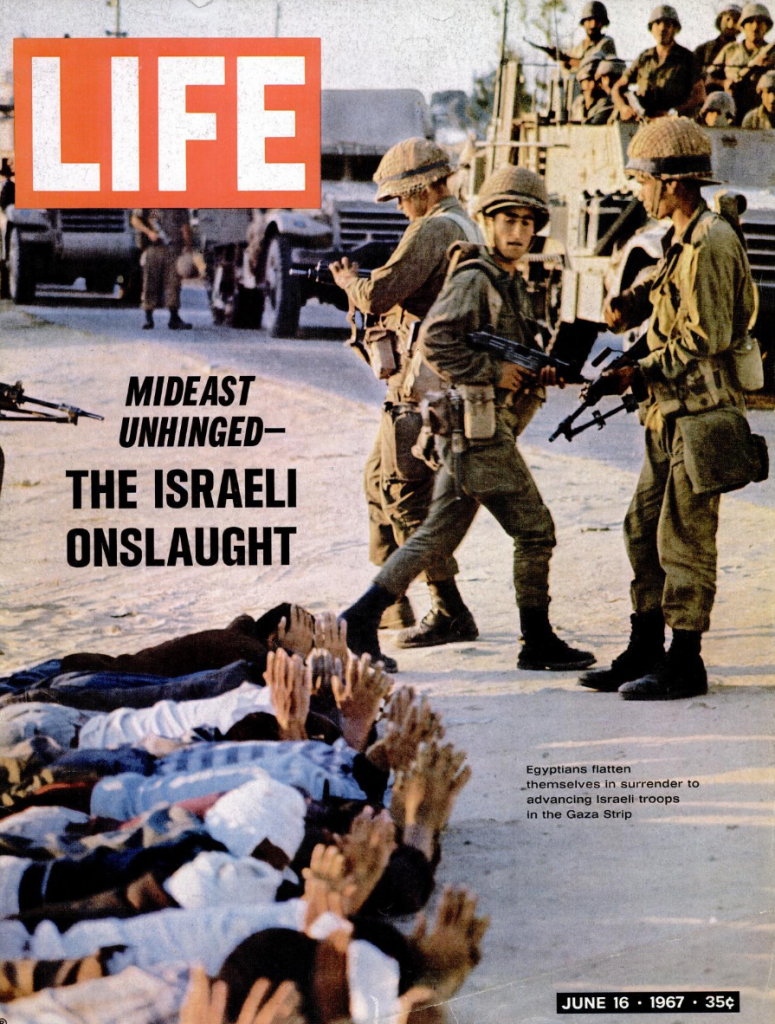
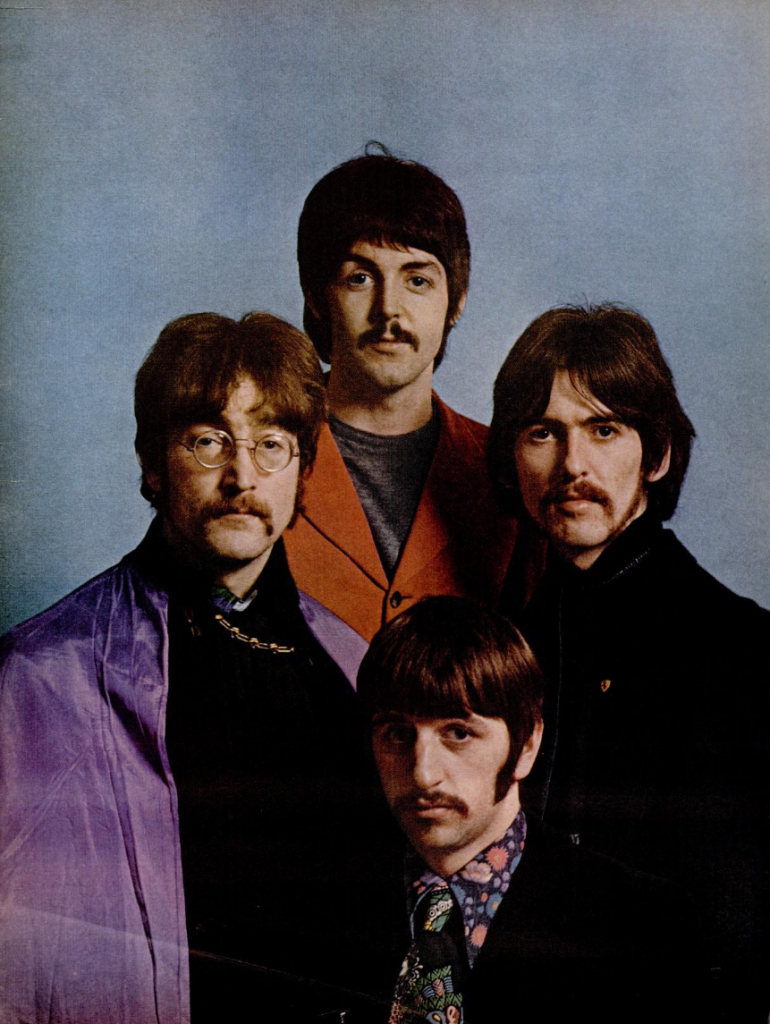
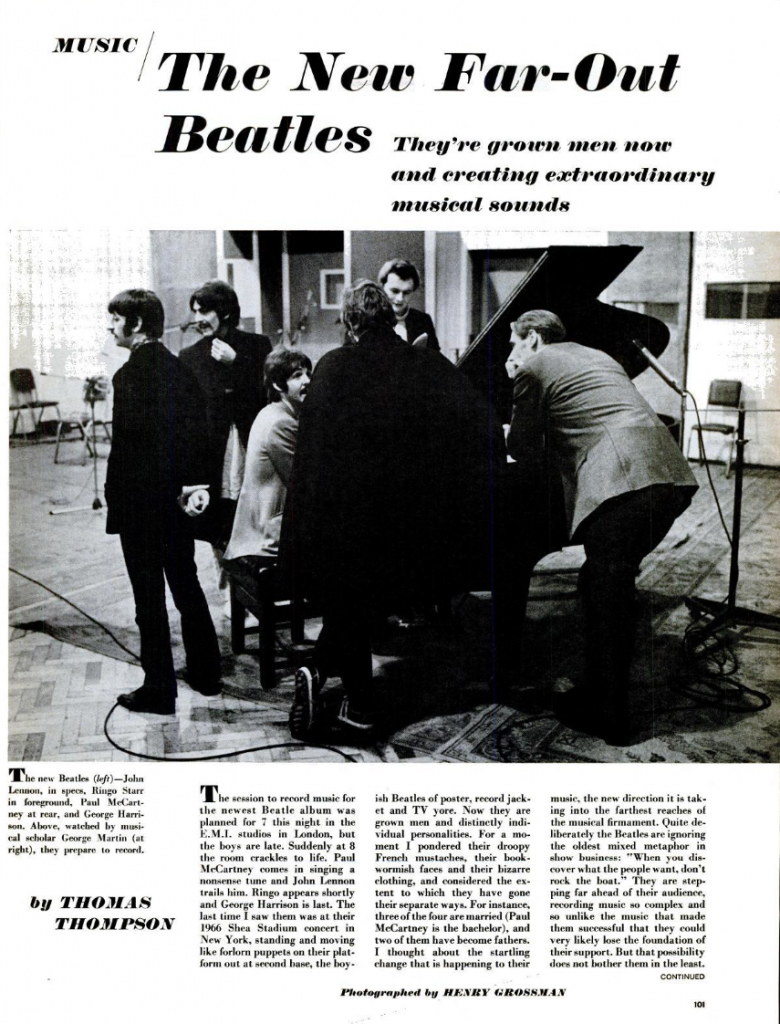
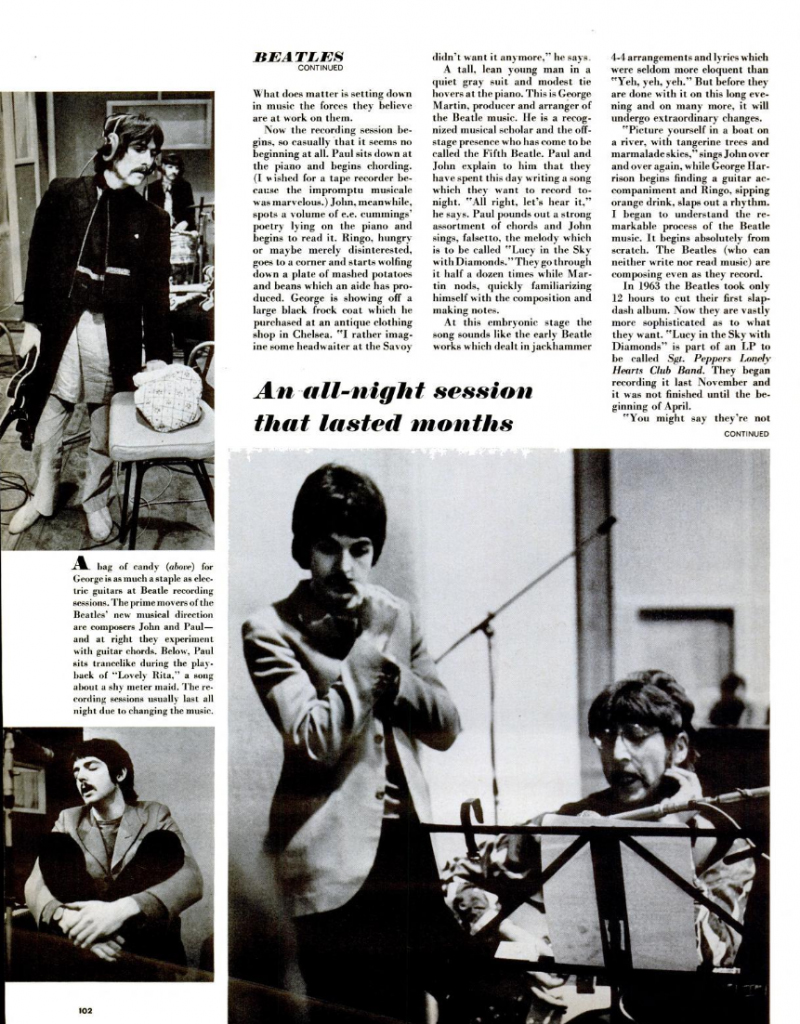
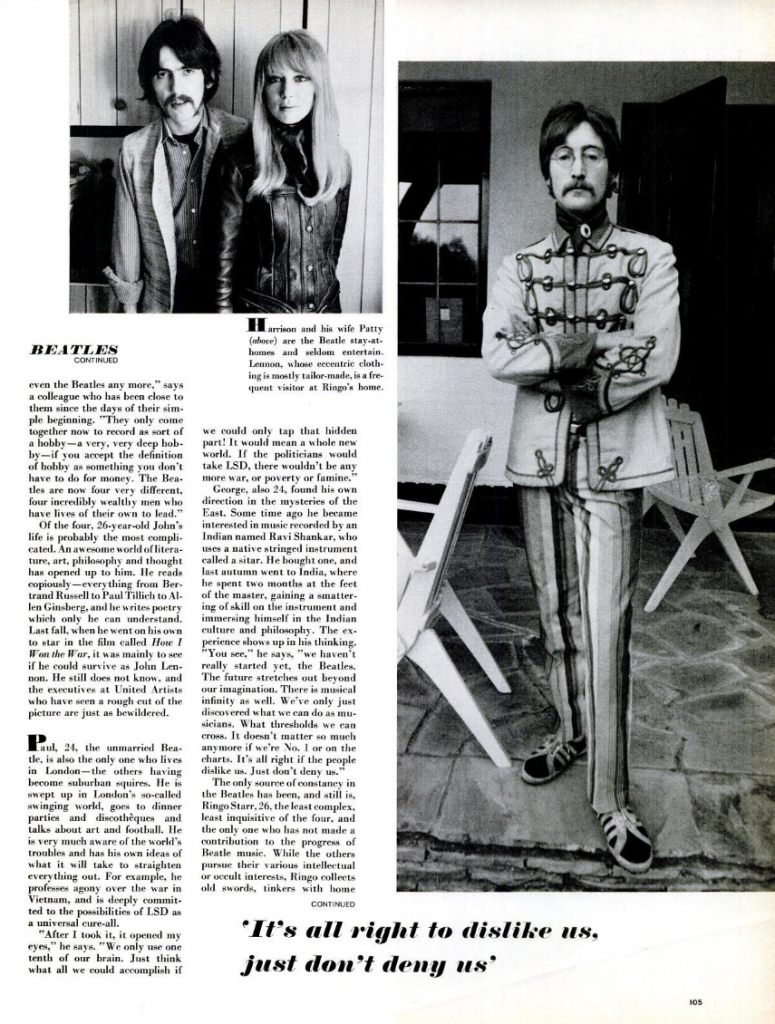
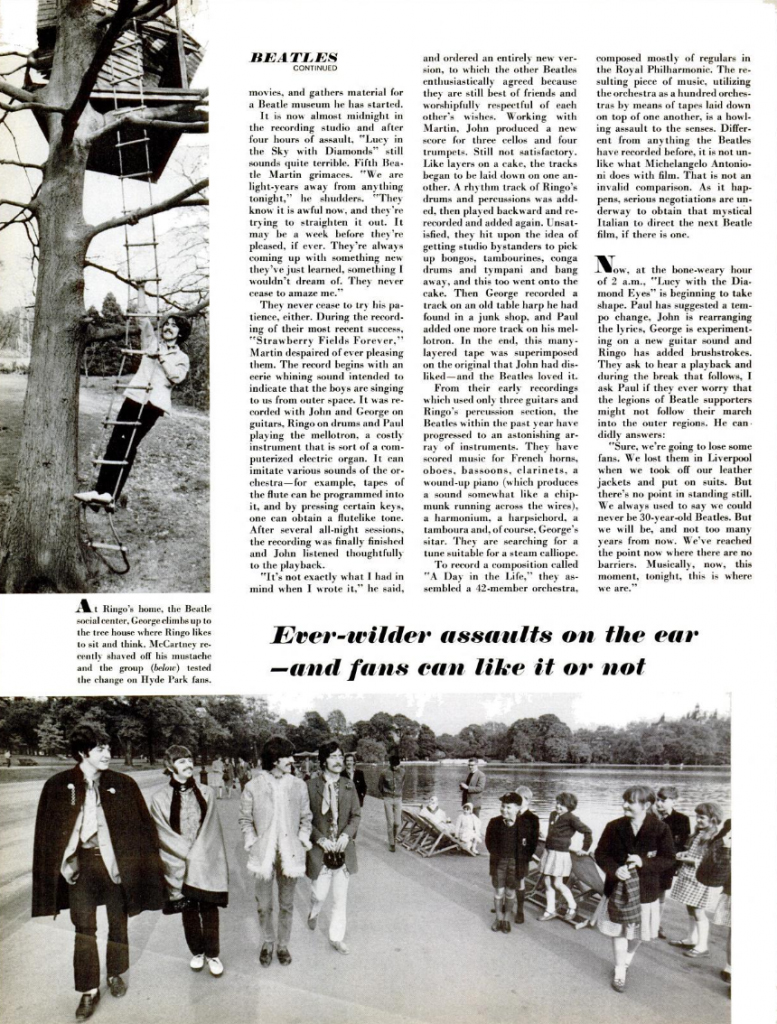
Last updated on April 21, 2024
Going further
If we like to think, in all modesty, that the Paul McCartney Project is the best online ressource for everything Paul McCartney, The Beatles Bible is for sure the definitive online site focused on the Beatles. There are obviously some overlap in terms of content between the two sites, but also some major differences in terms of approach.



Contribute!
Have you spotted an error on the page? Do you want to suggest new content? Or do you simply want to leave a comment ? Please use the form below!